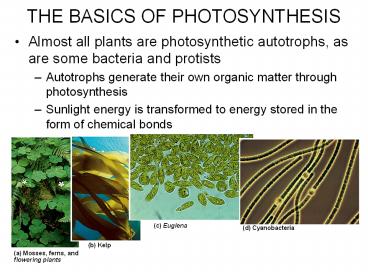Photosynthesis.PPT - PowerPoint PPT Presentation
Title:
Photosynthesis.PPT
Description:
THE BASICS OF PHOTOSYNTHESIS Almost all plants are photosynthetic autotrophs, as are some bacteria and protists Autotrophs generate their own organic matter through ... – PowerPoint PPT presentation
Number of Views:125
Avg rating:3.0/5.0
Title: Photosynthesis.PPT
1
THE BASICS OF PHOTOSYNTHESIS
- Almost all plants are photosynthetic autotrophs,
as are some bacteria and protists
- Autotrophs generate their own organic matter
through photosynthesis - Sunlight energy is transformed to energy stored
in the form of chemical bonds
(c) Euglena
(d) Cyanobacteria
(b) Kelp
- (a) Mosses, ferns, and
- flowering plants
2
Light Energy Harvested by Plants Other
Photosynthetic Autotrophs
6 CO2 6 H2O light energy ? C6H12O6 6 O2
3
WHY ARE PLANTS GREEN?
Plant Cells have Green Chloroplasts
The thylakoid membrane of the chloroplast is
impregnated with photosynthetic pigments (i.e.,
chlorophylls, carotenoids).
4
THE COLOR OF LIGHT SEEN IS THE COLOR NOT ABSORBED
- Chloroplasts absorb light energy and convert it
to chemical energy
Reflected light
Light
Absorbed light
Transmitted light
Chloroplast
5
AN OVERVIEW OF PHOTOSYNTHESIS
- Photosynthesis is the process by which
autotrophic organisms use light energy to make
sugar and oxygen gas from carbon dioxide and
water
Carbondioxide
Water
Glucose
Oxygengas
PHOTOSYNTHESIS
6
AN OVERVIEW OF PHOTOSYNTHESIS
- The light reactions convert solar energy to
chemical energy - Produce ATP NADPH
Light
Chloroplast
NADP?
ADP P
Calvin cycle
- The Calvin cycle makes sugar from carbon dioxide
- ATP generated by the light reactions provides the
energy for sugar synthesis - The NADPH produced by the light reactions
provides the electrons for the reduction of
carbon dioxide to glucose
Light reactions
7
PHOTOSYNTHESIS
- Sunlight provides ENERGY
CO2 H2O produces Glucose Oxygen
6CO2 6H2O C6H12O6 6O2
8
Steps of Photosynthesis
- Light hits reaction centers of chlorophyll, found
in chloroplasts
- Chlorophyll vibrates and causes water to break
apart.
- Oxygen is released into air
- Hydrogen remains in chloroplast attached to
NADPH - THE LIGHT REACTION
9
Steps of Photosynthesis
- The DARK Reactions Calvin Cycle
- CO2 from atmosphere is joined to H from water
molecules (NADPH) to form glucose
- Glucose can be converted into other molecules
with yummy flavors!
10
Photosynthesis occurs in chloroplasts
- In most plants, photosynthesis occurs primarily
in the leaves, in the chloroplasts - A chloroplast contains
- stroma, a fluid
- grana, stacks of thylakoids
- The thylakoids contain chlorophyll
- Chlorophyll is the green pigment that captures
light for photosynthesis
11
- The location and structure of chloroplasts
Chloroplast
LEAF CROSS SECTION
MESOPHYLL CELL
LEAF
Mesophyll
Intermembrane space
CHLOROPLAST
Outer membrane
Granum
Innermembrane
Stroma
Grana
Thylakoidcompartment
Stroma
Thylakoid
12
Chloroplast Pigments
- Chloroplasts contain several pigments
- Chlorophyll a
- Chlorophyll b
- Carotenoids
- Xanthophyll
Figure 7.7
13
SummaryLight Dependent Reactions
- a. Overall input
- light energy, H2O.
- b. Overall output
- ATP, NADPH, O2.
14
SummaryLight Independent Reactions
- a. Overall input
- CO2, ATP, NADPH.
- b. Overall output
- glucose.
15
Review Photosynthesis uses light energy to make
food molecules
- A summary of the chemical processes of
photosynthesis
Chloroplast
Light
Photosystem IIElectron transport chains
Photosystem I
CALVIN CYCLE
Stroma
Electrons
Cellular respiration
Cellulose
Starch
Other organic compounds
LIGHT REACTIONS
CALVIN CYCLE































